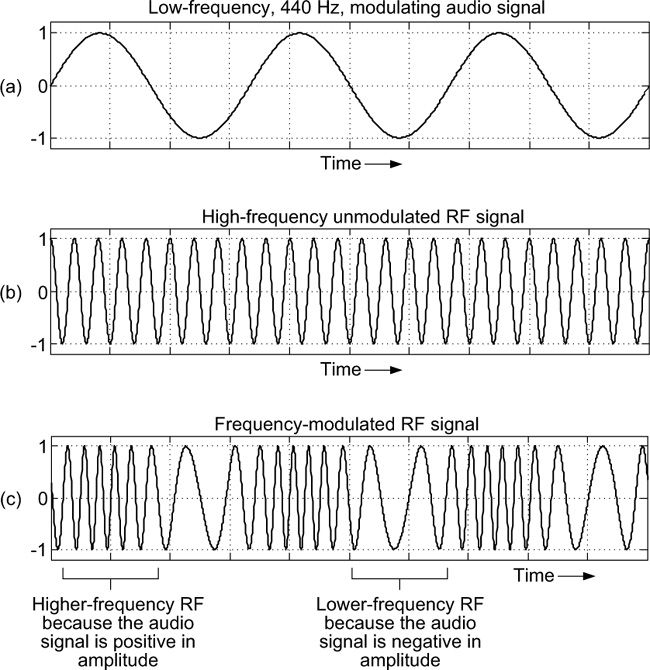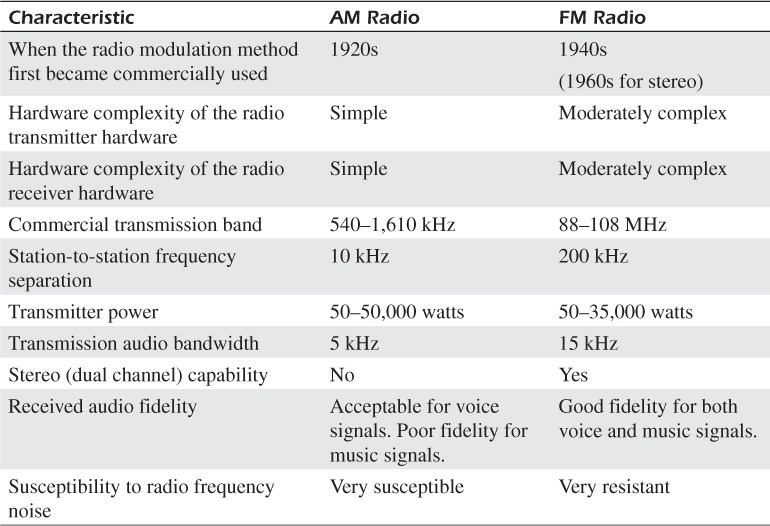C. AM and FM Radio Signals
To enhance your understanding of analog signals, it’s worth some effort to understand two types of analog signal that are “close to home,” AM and FM radio signals.
AM Radio Signals
At one time or another, everyone who reads this appendix has listened to an AM (amplitude modulation) radio, the oldest form of transmitting information using radio waves. AM is a way of embedding a low-frequency audio signal in a high-frequency radio signal. The radio signal is transmitted using an antenna, and AM radio receivers are able to extract the audio signal from the transmitted radio signal. The audio signal, in the form of a fluctuating voltage, is then amplified and applied to a loudspeaker. Let’s look at an example of those audio and radio frequency (RF) signals.
Figure C-1(a) shows a 440 Hz microphone output audio signal generated by the A key above middle C on a piano keyboard. Figure C-1(b) shows a high-frequency 1.2MHz (1.2 megahertz) RF sine wave voltage. If we multiply the RF sine wave signal by the low-frequency audio signal, the result is the modulated RF signal shown in Figure C-1(c). Notice that the modulated RF signal’s frequency remains at 1.2 Mhz but it’s peak-to-valley amplitude fluctuates as time passes. As shown by the dashed-line curve in Figure C-1(d), those amplitude fluctuations are called the envelope of the modulated RF signal.

Figure C-1 AM radio signals: (a) 440 Hz audio tone; (b) unmodulated 1.2 Mhz RF (radio frequency) sine wave signal; (c) amplitude-modulated RF signal; (d) RF signal’s envelope (dashed curve).
The crucial result here is that the modulated RF signal’s envelope is identical to the 440 Hz modulating audio signal in Figure C-1(a). So when the Figure C-1(c) amplitude-modulated RF signal is transmitted as an electromagnetic wave using an antenna, an AM radio receiver can be tuned to 1.2 Mhz and extract the RF envelope audio signal from the modulated radio signal. In the radio receiver, the extracted 440 Hz audio signal is amplified, applied to a loudspeaker, and we then hear the 440 Hz A-key musical note of a piano.
In a similar manner, if the low-frequency modulating audio signal were a voice signal from a microphone, we’d hear human speech from our AM receiver’s loudspeaker. As for the spectrum of a broadcast AM signal, that topic is covered in the early part of Chapter 5.
During the second half of the twentieth century, all video (image) signals of commercial analog television were broadcast using AM technology. (Some of you might remember the elaborate television antennas mounted atop every home and apartment.) However, combined with those AM video signals were the television audio signals, which were broadcast using a technique called frequency modulation. That is our next subject.
FM Radio Signals
To understand the analog signals used in FM (frequency modulation) radio, let’s again think about a 440 Hz audio signal from the A key on a piano and a high-frequency 1.2MHz RF sine wave voltage. Those signals are shown in Figure C-2(a) and in Figure C-2(b).

Figure C-2 FM radio signals: (a) 440 Hz audio tone; (b) unmodulated high-frequency RF sine wave signal; (c) frequency-modulated RF signal.
In FM radio, the frequency of the RF sine wave signal is controlled (modulated) by the 440 Hz audio signal. As shown in Figure C-2(c), the modulated RF signal’s frequency is increased when the 440 Hz modulating audio signal has a positive amplitude. And the RF signal’s frequency is decreased when the audio signal has a negative amplitude. The result is a high-frequency FM radio signal whose instantaneous frequency depends on the amplitude of the modulating audio signal.
The Figure C-2(c) frequency-modulated RF signal is then transmitted as an electromagnetic wave using an antenna. When an FM radio receiver is tuned to 1.2 Mhz, the receiver generates a signal whose amplitude depends on the instantaneous frequency of the high-frequency FM RF signal. That generated signal is identical to the 440 Hz audio modulating signal. The generated signal is amplified, applied to a loudspeaker, and we hear the 440 Hz A-key musical note of a piano. If the low-frequency modulating audio signal had been a voice signal from a microphone, we’d hear human speech from our FM receiver’s loudspeaker.
Comparing AM and FM Radio
Table C.1 provides a brief comparison of commercial AM and FM radio as it is used in the United States.
By the Way
In general, history books proclaim Italian experimenter Guglielmo Marconi as the inventor of radio. The fact is, the first person to implement radio transmission and reception was the enigmatic American engineer Nikola Tesla in 1895. In late 1901, with the backing of wealthy benefactors, Marconi became famous for transmitting Morse code signals across the Atlantic Ocean. What wasn’t advertised was the fact that Marconi used Tesla-invented oscillator coils for his transatlantic demonstration. Battles over patents raged between Tesla and Marconi for decades. With the drop of the gavel in 1943, a few months after Tesla’s death, the U.S. Supreme Court upheld patent number 645,576—Tesla’s original radio patent. Sadly, historians have ignored that court decision.

